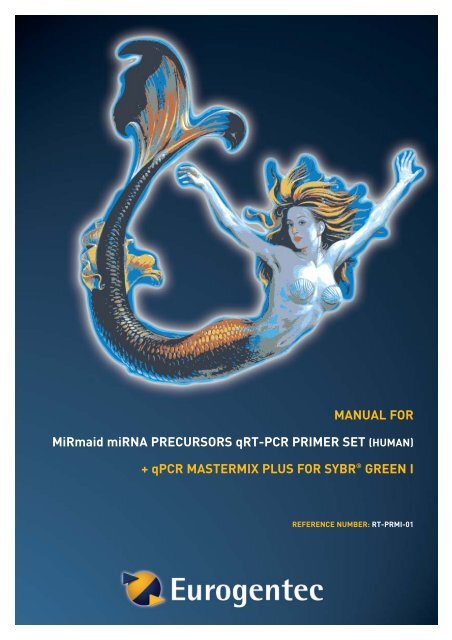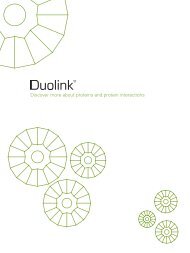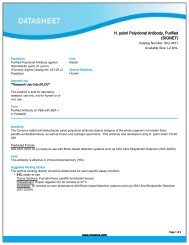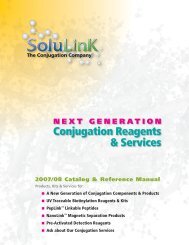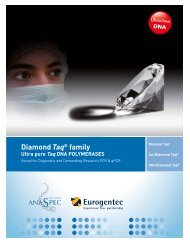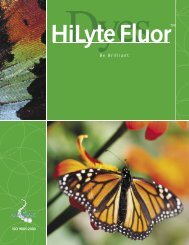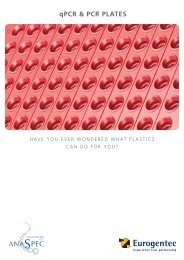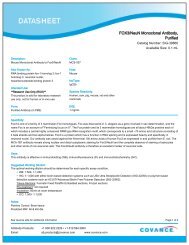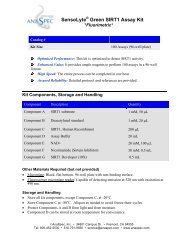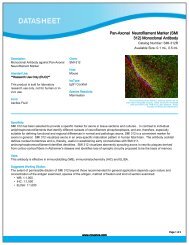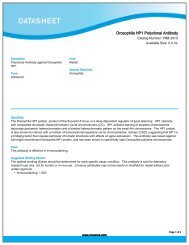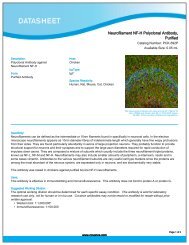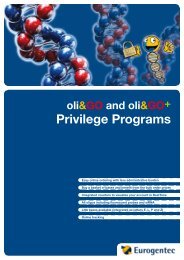Safety information - Eurogentec
Safety information - Eurogentec
Safety information - Eurogentec
You also want an ePaper? Increase the reach of your titles
YUMPU automatically turns print PDFs into web optimized ePapers that Google loves.
MANUAL FOR<br />
MiRmaid miRNA PRECURSORS qRT-PCR PRIMER SET (HUMAN)<br />
+ qPCR MASTERMIX PLUS FOR SYBR ® GREEN I<br />
REFERENCE NUMBER: RT-PRMI-01
2<br />
Table of contents<br />
Intended use 3<br />
Shipping and storage conditions 3<br />
<strong>Safety</strong> <strong>information</strong> 3<br />
Background Information 4<br />
Kit contents 6<br />
MiRmaid miRNA precursors qRT-PCR primer set components 7<br />
Additional required material 7<br />
Standard protocol 8<br />
1. Reagent handling 8<br />
2. RNA preparation 8<br />
3. DNase and Reverse Transcription Reactions 9<br />
4. Quantitative qPCR Reaction 10<br />
5. How to set up a good assay 12<br />
Typical results 14<br />
Troubleshooting guide 15<br />
Homology between human pre-miRNA primers and rodent sequences 19<br />
Guidelines for successful RT-qPCR 20<br />
Ordering <strong>information</strong> 21<br />
Related products 23<br />
Appendix 1: Layout of MiRmaid qPCR primer plate #1 24<br />
Appendix 2: Layout of MiRmaid qPCR primer plate #2 24<br />
Appendix 3: qPCR MasterMixes compatibility with Real-Time thermocyclers 25<br />
Trademarks and disclaimer 26<br />
Manual for MiRmaid miRNA precursor qRT-PCR Primer Set I www.eurogentec.com I info@eurogentec.com
Intended use<br />
The <strong>Eurogentec</strong> MiRmaid miRNA precursors qRT-PCR primer set – designed by DNA<br />
Vision - was developed and optimized for the amplification of the human precursor<br />
microRNAs (pre-miRNAs) by performing a reverse transcription (RT) followed by a<br />
Real-Time qPCR using SYBR ® Green I assay.<br />
This product is sold for research use only. The kit is not intended for use in diagnostic<br />
or therapeutic procedures. Do not use internally or externally in humans or animals.<br />
All miRNAs that can be amplified with the MiRmaid miRNA precursors qRT-PCR primer set are<br />
listed in appendix 1 and 2 (as miRNA names evolve quickly along time you will find a conversion<br />
table on our website giving the new miRNA names corresponding to our miRNA MiRmaid names).<br />
Reference center: Dr. Ogier D. - INSERM U773 - Centre de recherche Bichat Beaujon - CRB3 - Paris - France<br />
Shipping and storage conditions<br />
The MiRmaid miRNA precursors qRT-PCR primer set kit is shipped on dry ice.<br />
Upon receipt, the MiRmaid RT primer MasterMIX, the 2 MiRmaid qPCR primer plates,<br />
the qPCR MasterMix Plus for SYBR ® Green I and the extra tube 50 mM MgCl 2 should<br />
be stored at -20 °C (-18 °C to –24 °C) in a constant temperature freezer to maintain<br />
stability. Repeated freeze-thaw cycles (more than 5) should be avoided.<br />
When stored under these conditions the reagents are stable for at least 1 year.<br />
The qPCR MasterMix Plus for SYBR ® Green I should be protected from light whenever possible.<br />
<strong>Safety</strong> <strong>information</strong><br />
This product and its components should be handled only by persons trained in<br />
laboratory techniques and used in accordance with the principles of good laboratory<br />
practice. All chemicals should be considered potentially hazardous. Therefore, when<br />
handling chemical reagents, it is advisable that suitable protective clothing, gloves and<br />
eye/face protection are worn. Care should be taken to avoid contact with skin or eyes.<br />
In case of contact, wash immediately with water and seek medical advice.<br />
DMSO, in which SYBR ® Green I is dissolved, may cause eye, skin, and respiratory tract<br />
irritation. It is readily absorbed through the skin. DMSO is a combustible liquid and<br />
vapor that should be kept away from heat and flame. The product contains material,<br />
Manual for MiRmaid miRNA precursor qRT-PCR Primer Set I www.eurogentec.com I<br />
info@eurogentec.com 3
4<br />
which may cause liver and blood damage. We recommend wearing a lab coat,<br />
disposable gloves, and protective goggles when working with these chemicals.<br />
For more <strong>information</strong> about safety and handling of reagents please consult the<br />
Material <strong>Safety</strong> Data Sheets (MSDSs) of this kit and its components. These are<br />
available as PDFs on our website at www.eurogentec.com/code/en/msds.asp.<br />
Background <strong>information</strong><br />
Figure 1 : miRNA Biogenesis and siRNA Pathway<br />
MicroRNAs (miRNA) represent an abundant class of endogenous non-coding RNA<br />
molecules that regulate fundamental processes such as cell proliferation, cell<br />
differentiation or apoptosis through modulation of gene expression (1 and 2).<br />
Manual for MiRmaid miRNA precursor qRT-PCR Primer Set I www.eurogentec.com I info@eurogentec.com
miRNA genes are usually transcribed by RNA Polymerase II into capped,<br />
polyadenylated and spliced transcripts (cf figure 1). miRNA-containing sequences<br />
from one or more hairpin loop structures that are called primary miRNA structure<br />
(pri-miRNA). The RNase III Drosha-DGCR8 nuclear complex cleaves the base of the<br />
hairpin to form a precursor molecule called pre-miRNA (3-5). Most pre-miRNAs are<br />
comprised between 70-120 nt with 1-4 nt 3' overhangs, and form a 25–30 bp hairpin<br />
loop structure. The pre-miRNA molecule is then actively transported out of the<br />
nucleus into the cytoplasm by Exportin 5, a carrier protein. The Dicer enzyme (a key<br />
enzyme of the siRNA pathway) then cuts 19-25 nucleotides from the base of the<br />
hairpin (approximately 19 bp from Drosha's cut site) to release a double-stranded RNA<br />
molecule with 1–4 nt 3' overhangs at either end (6,7). Only one strand of the duplex<br />
(called the mature miRNA) is incorporated into the RISC (RNA-Induced Silencing<br />
Complex) or miRNP complex, a protein complex that, when bound to a miRNA, is<br />
responsible for the post-transcriptional regulation of the corresponding target protein<br />
by an unknown mechanism.<br />
In the RNA interference (RNAi) phenomenon, the Dicer also processes the synthetic<br />
small interfering RNA (siRNA) from longer precursors. The antisense strand of the<br />
siRNA serves as a template for the RISC to recognize and cleave a complementary<br />
messenger (cf figure 1, siRNA pathway).<br />
The mature miRNAs have been shown to reduce steady state protein levels for the<br />
targeted gene(s) by binding on its 3’UTR with or without impacting the corresponding<br />
levels of mRNA. The mechanisms by which miRNAs reduce protein levels are not fully<br />
understood. These post-transcriptional events, would take place in the dynamic<br />
cytoplasmic structures, called P-body or GW body (8,9-11). Moreover, a single miRNA<br />
can bind to and regulate many different mRNA targets or can bind at several positions<br />
on a same UTR. Conversely, several different miRNAs can bind to and cooperatively<br />
control a single mRNA.<br />
Several studies indicate that miRNAs may regulate the translation as much as 30 % of<br />
all genes in the genome. miRNAs have already been found to involve into several types<br />
of cancers, cell differentiation, proliferation and viral infection. miRNA expression<br />
varies from tissue to tissue and looks also highly regulated during the development in<br />
a temporal way.<br />
Interestingly, a recent study performed at the MIT on different types of cancer has<br />
shown that miRNAs signatures are more informative than classical mRNAs ones. They<br />
observed so far an increase of the abundance of the miRNAs matures in cancer<br />
compare to the normal situation without the detection of a substantial decrease in the<br />
mRNAs encoding components of the miRNAs processing machinery (Dicer, Drosha,<br />
Argonaute 2 or DGCR8). This observation suggests either the existence of other<br />
Manual for MiRmaid miRNA precursor qRT-PCR Primer Set I www.eurogentec.com I<br />
info@eurogentec.com 5
6<br />
mechanisms of regulation or it is the expression of the miRNAs, which is affected, or<br />
therefore the analysis of the expression of the pre-miRNAs become highly relevant (12).<br />
Reference<br />
1. Bartel, DP. MicroRNAs: genomics, biogenesis, mechanism, and function. Cell 2004; 116: 281-97<br />
2. Lai, EC. microRNAs: runts of the genome assert themselves. Curr Biol 2003; 13: R925-36<br />
3. Hutvagner, G, McLachlan, J, Pasquinelli, AE, Balint, E, Tuschl, T and Zamore, PD. A cellular function for the RNAinterference<br />
enzyme Dicer in the maturation of the let-7 small temporal RNA. Science 2001; 293: 834-8<br />
4. Lee, Y, Ahn, C, Han, J, Choi, H, Kim, J, Yim, J, Lee, J, Provost, P, Radmark, O, Kim, S and Kim, VN. The nuclear RNase<br />
III Drosha initiates microRNA processing. Nature 2003; 425: 415-9<br />
5. Lee, YS, Nakahara, K, Pham, JW, Kim, K, He, Z, Sontheimer, EJ and Carthew, RW. Distinct roles for Drosophila Dicer-<br />
1 and Dicer-2 in the siRNA/miRNA silencing pathways. Cell 2004; 117: 69-81<br />
6. Khvorova, A, Reynolds, A and Jayasena, SD. Functional siRNAs and miRNAs exhibit strand bias. Cell 2003; 115: 209-16<br />
7. Schwarz, DS, Hutvagner, G, Du, T, Xu, Z, Aronin, N and Zamore, PD. Asymmetry in the assembly of the RNAi enzyme<br />
complex. Cell 2003; 115: 199-208<br />
8. Liu, J, Valencia-Sanchez, MA, Hannon, GJ and Parker, R. MicroRNA-dependent localization of targeted mRNAs to<br />
mammalian P-bodies. Nat Cell Biol 2005; 7: 719-23<br />
9. Pauley, KM, Eystathioy, T, Jakymiw, A, Hamel, JC, Fritzler, MJ and Chan, EK. Formation of GW bodies is a consequence<br />
of microRNA genesis. EMBO Rep 2006; 7: 904-10<br />
10. Rehwinkel, J, Behm-Ansmant, I, Gatfield, D and Izaurralde, E. A crucial role for GW182 and the DCP1:DCP2<br />
decapping complex in miRNA-mediated gene silencing. Rna 2005; 11: 1640-7<br />
11. Bruno, I and Wilkinson, MF. P-bodies react to stress and nonsense. Cell 2006; 125: 1036-8<br />
12. Lu, J, Getz, G, Miska, EA, Alvarez-Saavedra, E, Lamb, J, Peck, D, Sweet-Cordero, A, Ebert, BL, Mak, RH,<br />
Ferrando, AA, Downing, JR, Jacks, T, Horvitz, HR and Golub, TR. MicroRNA expression profiles classify<br />
human cancers. Nature 2005; 435: 834-8<br />
Kit contents<br />
The <strong>Eurogentec</strong> MiRmaid miRNA precursors qRT-PCR primer set (reference<br />
RT-SYMI-025) contains sufficient MiRmaid RT primer MasterMIX to perform 50 RT<br />
(Reverse Transcriptase) reactions, which is enough for 25 different samples. The amount<br />
of cDNA produced after 1 RT reaction should allow performing 96 qPCR reactions.<br />
The qPCR MasterMix Plus for SYBR ® Green I is a 2X concentrated, ready-to use reaction<br />
buffer containing dNTP/dUTP mix, HotGoldStar, UNG, MgCl 2, SYBR ® Green I, stabilizers<br />
and ROX passive reference. An extra tube of 50 mM MgCl 2 is provided. The qPCR<br />
MasterMix Plus for SYBR ® Green I contains enough reagents for performing up to 600-<br />
25 μl reactions.<br />
If for the Real-Time thermocycler that is used another qPCR MasterMix is required, please refer to our<br />
Real-Time qPCR MasterMix compatibility table with each Real-Time thermocyclers in appendix 3.<br />
The 2 MiRmaid qPCR primer plates contain 112 μl of the specific miRNA Reverse and<br />
Forward primers in each tube. These 170 pre-miRNA F and R primer mixes and the<br />
4 positive control mixes are sufficient to perform at least 25 Real-Time qPCR reactions.<br />
If the qPCR analysis should be performed in duplicates please order a second qPCR MasterMix<br />
Plus for SYBR ® Green I separately (reference # RT-SN2X-03+).<br />
Manual for MiRmaid miRNA precursor qRT-PCR Primer Set I www.eurogentec.com I info@eurogentec.com
MiRmaid miRNA precursors qRT-PCR primer set<br />
components<br />
2x reaction buffer (amber bottle - blue cap)* 7.5 ml<br />
• One bottle of reaction buffer containing dNTP/dUTP mix, HotGoldStar, UNG, MgCl 2 (5 mM<br />
final concentration), SYBR ® Green I, stabilizers and passive reference<br />
• Sufficient to perform 600-25 μl reactions.<br />
• Store at –20 °C<br />
(* ) The SYBR ® Green is light sensitive and should be kept away from light as much as possible<br />
50 mM MgCl 2 (plain cap) 1.5 ml<br />
• One tube of 50 mM MgCl 2<br />
• Store at -20 °C<br />
MiRmaid RT primer MasterMIX (red cap) 765 μl<br />
• One tube of specific miRNA RT primers at 10 μM each<br />
• Sufficient to perform 50 RT reactions (25 samples)<br />
• Store at -20 °C<br />
2 MiRmaid qPCR primer plates 112 μl<br />
• Two plates with 170 tubes containing 112 μl of specific miRNA Forward and Reverse qPCR<br />
primers at 2.5 μM. 4 positive controls are included in each plate (112 μl of specific Forward<br />
and Reverse primers at 2.5 μM)<br />
• Sufficient to perform at least 25 qPCR using 4 μl.<br />
• Store at -20 °C<br />
Layout of the 2 plates can be found in the cover of each plate and in appendix 1 and 2 of this manual.<br />
Additional required material<br />
• Real-Time Thermocycler<br />
• Deoxyribonuclease I, Amplification grade<br />
• SuperScript III Reverse Transcriptase<br />
• dNTP 10 mM each (Reference NU-0020-10)<br />
• QIAquick Nucleotide Removal Kit, Qiagen cat 28304<br />
• Sterile, RNase-free 1.5 ml microtubes<br />
• Sterile-barrier, RNase-free pipette tips<br />
• RNase-free water<br />
• EDTA (10mM, pH 8.0)<br />
• DTT (0.1 M) - provided with the SuperScript III<br />
• PCR-tubes<br />
Manual for MiRmaid miRNA precursor qRT-PCR Primer Set I www.eurogentec.com I<br />
info@eurogentec.com 7
8<br />
Standard protocol<br />
1. Reagent handling<br />
• Thaw all required reagents completely and put them on ice.<br />
• Mix all reagents well by inversion and spin them down prior to pipetting.<br />
2. RNA preparation<br />
The quality of the RNA is essential to the overall success of the all data from MiRmaid<br />
miRNA precursors qRT-PCR primer set.<br />
• Clean your work area before starting with RNAZap product or equivalent.<br />
• Wear clean lab coat and gloves at any time (and change them whenever you suspect<br />
that they are contaminated).<br />
• Use RNase free tips and tubes.<br />
Tips<br />
The pre-miRNAs look highly sensitive to RNA degradation, therefore the quality of the<br />
RNA should be checked before and after DNase treatment on an Agilent Bioanalyser<br />
2100 if possible (or at least on agarose gel figure 2). A ratio 260/280 of 1.8 - 2.0 as well<br />
as a perfect electropherogram are crucial to guarantee highly specific amplification.<br />
Moreover, because of the small size of the pre-miRNAs, it is recommended not using<br />
any total RNA extraction protocol based on exclusion column, as with this method all<br />
small RNAs would be lost.<br />
We recommend working on total<br />
RNA extracted with Trizol or RNABle<br />
RNA Extraction procedure. The<br />
figure 3 shows the analysis of total<br />
RNA after RNABle RNA Extraction,<br />
data obtained with the Agilent<br />
Bioanalyser 2100.<br />
Figure 2: Results on agarose gel 2 %<br />
TThhee ttoottaall RRNNAA iiss eexxttrraacctteedd wwiitthh tthhee RRNNAABBllee<br />
pprroocceedduurree..<br />
A smear around 150 bp shows the presence of<br />
small RNAs after DNase treatment.<br />
1 2 3 4<br />
Before After<br />
DNase treatment<br />
Manual for MiRmaid miRNA precursor qRT-PCR Primer Set I www.eurogentec.com I info@eurogentec.com<br />
DNA ladder<br />
4000 bp<br />
800 bp<br />
350 bp<br />
150 bp
5S<br />
18S<br />
3. DNase and Reverse Transcription Reactions<br />
DNase treatment<br />
28S<br />
The first step after total RNA extraction is a treatment with a Deoxyribonuclease<br />
enzyme (DNase). This step is indispensable for removing DNA contamination from<br />
RNA samples prior to RT.<br />
1. Take 1 μg of total RNA (this quantity is enough for 96 qPCR reactions).<br />
2. Prepare a reaction mix by combining the following component in order as detailed<br />
below, to perform the DNase treatment.<br />
COMPONENT VOLUME<br />
Total RNA 1 μg (quantity is enough for 96 reactions)<br />
Deoxyribonuclease I, Amplification grade 1 μl<br />
DNase Buffer 1 μl<br />
RNase free water Volume is 10.5 μl minus all other component<br />
value<br />
Total mix 10.5 μl<br />
RT minus control: We recommend preparing 2 tubes in parallel with this mix preparation. One tube will be<br />
used as RT minus control in which no reverse transcription takes place in order to check whether the RNA<br />
preparation contains genomic DNA after the DNase treatment.<br />
3. Incubate 15 minutes at room temperature.<br />
4. Add 1 μl of EDTA (10 mM, pH8) to stop the DNase reaction.<br />
RT minus control: In the tube that will be used as no reverse transcriptase control, add 37.5 μl of RNase free<br />
water. Save it at -20 °C and use it directly in the step 15.<br />
Manual for MiRmaid miRNA precursor qRT-PCR Primer Set I www.eurogentec.com I<br />
Figure 3 : Result from Agilent Bioanalyser<br />
2100.<br />
TThhee ttoottaall RRNNAA iiss eexxttrraacctteedd wwiitthh tthhee RRNNAABBllee<br />
pprroocceedduurree..<br />
Presence of the peak corresponding to the<br />
positive control 5S shows that small RNAs<br />
have been correctly extracted.<br />
info@eurogentec.com 9
10<br />
Reverse Transcriptase reaction<br />
5. Thaw the MiRmaid RT primer MasterMIX (red cap) completely and put it on ice.<br />
Vortex briefly and make a short spin by centrifugation.<br />
6. Add 15 μl MiRmaid RT primer MasterMIX to the RNA/DNase treated tube (from step 4).<br />
7. Incubate 5 minutes at 80 °C.<br />
8. Incubate 5 minutes at 60 °C.<br />
9. Incubate 10 minutes at room temperature.<br />
10. Prepare a RT reaction mix by combining the following components, in order, as<br />
detailed below.<br />
COMPONENT VOLUME<br />
5x first strand buffer 9.6 μl<br />
DTT 4.8 μl<br />
dNTP (10 mM) 1.2 μl<br />
RNase free water 5.9 μl<br />
Total mix 21.5 μl<br />
11. Add the RT Reaction mix to RT primer MasterMIX + RNA tube (from step 6).<br />
12. Incubate 2 minutes at 50 °C.<br />
13. Add 1.6 μl of Superscript III.<br />
14. Incubate for 60 minutes at 50 °C.<br />
15. Purify the product with the QIAquick Nucleotide Removal Kit and elute with 40 μl<br />
of EB buffer.<br />
16. Add EB buffer (+/- 285 μl) to the eluate so that the final volume of cDNA is 325 μl.<br />
4. Quantitative qPCR reaction<br />
1. Prepare a qPCR reaction mix by combining the following components in order as<br />
detailed below. It is recommended preparing a volume of reaction mix 10 % to 15 %<br />
greater than required for the total number of reactions (please find an example for<br />
96 reactions also in the table below).<br />
Manual for MiRmaid miRNA precursor qRT-PCR Primer Set I www.eurogentec.com I info@eurogentec.com
COMPONENT VOLUME PER WELL VOLUME FOR 96 REACTIONS<br />
Manual for MiRmaid miRNA precursor qRT-PCR Primer Set I www.eurogentec.com I<br />
+ 12 % (= 107.5 REACTIONS)<br />
2x reaction buffer 12.5 μl 1342 μl<br />
cDNA (from step 16) 3.0 μl 324 μl<br />
PCR Grade water 5.5 μl 594 μl<br />
Total MIX 21 μl 2260 μl<br />
2. Thaw the MiRmaid miRNA qPCR primer tubes necessary to perform the assay<br />
(please find the layout of the primer sets under the cover of each plate or in the<br />
appendix 1 and 2 of this manual).<br />
3. Make sure that the qPCR reaction mix is thoroughly mixed (do not vortex). Per well,<br />
aliquot 21 μl of this qPCR reaction mix and 4 μl of each MiRmaid qPCR primers.<br />
Final volume is 25 μl per well. Make sure that no bubbles are present in the tubes.<br />
Positive controls: It is recommended to perform positive controls using the 4 controls provided in each<br />
plate ( U6, 5S, HMBS and TBP).<br />
No-template controls: A negative control containing no cDNA template should also always be included.<br />
Do not forget to run the RT minus control.<br />
4. Centrifuge briefly to avoid bubbles.<br />
5a. Program the Real-Time thermocycler using the following cycling conditions:<br />
HotGoldStar activation 10 min 95 °C<br />
40 Cycles 15 sec 95 °C<br />
1 min 60 °C<br />
Data collection should be done at 60 °C.<br />
Perform a meltcuve to ensure the specificity of the product amplified.<br />
Dissociation Curve 15 sec 95 °C<br />
15 sec 60 °C<br />
(Ramping time: 19’59’’ with fluorescence reading)<br />
15 sec 95 °C<br />
5b. Program the Real-Time thermocycler using the following cycling conditions when<br />
using Uracil-N-Glycosylase:<br />
UNG step 2 min 50 °C<br />
HotGoldStar activation / UNG inactivation 10 min 95 °C<br />
info@eurogentec.com 11
12<br />
40 Cycles 15 sec 95 °C<br />
1 min 60 °C<br />
Data collection should be done at 60°C.<br />
Perform a meltcuve to ensure the specificity of the product amplified.<br />
Dissociation Curve 15 sec 95 °C<br />
15 sec 60 °C<br />
(Ramping time: 19’59’’ with fluorescence reading)<br />
15 sec 95 °C<br />
5. How to set up a good assay<br />
RNA quality<br />
The quality of the RNA is essential to the overall success of the all data from MiRmaid<br />
miRNA precursors qRT-PCR primer set. Clean laboratory practice is important to<br />
avoid degradation of the RNA (please find more <strong>information</strong> in paragraph 2 of the<br />
standard protocol). As the pre-miRNAs look highly sensitive to RNA degradation it is<br />
very important to check the quality of RNA before and after DNase treatment on an<br />
Agilent Bioanalyser 2100 if possible or at least on an agarose gel (please find more<br />
<strong>information</strong> p.8). Also, it is important to ensure that small RNAs have been well and<br />
correctly extracted using the 5S and U6 positive controls (please find more<br />
<strong>information</strong> concerning positive controls below).<br />
No-Reverse Transcriptase control<br />
As indicated in step 2 of the DNase and Reverse Tanscription Reactions paragraph, it<br />
is recommended performing a No-Reverse Transcriptase control.<br />
This control assumes the total digestion of the genomic DNA, which could interfere<br />
with the cDNA amplification. This control includes all of the qPCR reagents with<br />
primer controls and the RNA treated by DNase without the reverse transcription step.<br />
If a product is amplified, it indicates that there is still some genomic DNA<br />
contamination.<br />
Manual for MiRmaid miRNA precursor qRT-PCR Primer Set I www.eurogentec.com I info@eurogentec.com
Positive controls<br />
It is highly recommended including positive controls in the assay. This is why, 4<br />
different controls have been included in the 2 MiRmaid qPCR primer plates. U6 and<br />
5S are small size RNAs comparable to the size of precursor miRNAs. We recommend<br />
checking the presence of 5S before and after DNase treatment to ensure that the<br />
small size RNAs have been correctly extracted. By amplifying the U6 and 5S positive<br />
controls by qPCR you will be able to check that the qPCR reaction have been<br />
performed correctly and that any small RNAs reverse transcribed to cDNA have been<br />
amplified correctly.<br />
Precursor miRNAs are very low expressed RNAs, however 6U and 5S positive controls<br />
are highly expressed RNAs, this is why 2 others qPCR low expressed positive controls,<br />
HMBS and TBP, have been added. These 2 positive controls are coming out at Ct<br />
values that are more or less comparable to the Ct values expected when amplifying<br />
precursor miRNAs.<br />
No-template control<br />
It is recommended for each sample tested performing a negative control.<br />
The no-template control includes all the qPCR reagents except the cDNA / DNA<br />
template. If a product is amplified, it indicates that one or more of the qPCR reagents<br />
are contaminated with DNA.<br />
Dissociation curve<br />
The specificity of the amplification must be checked by the dissociation curve to<br />
assume the validation of the Cts. Each amplification is associated to a specific<br />
prominent peak corresponding to the target pre-miRNA amplification product.<br />
Standard curve<br />
A stantard curve should always be used to check the performance and efficiency of<br />
the qPCR. The standard curve should cover the complete range of expected<br />
expression levels (in general 5 to 6 logs of magnitude). The equation that represents<br />
this curve can be used to accurately identify fold-variation between experimental<br />
samples.<br />
All the MiRmaid qPCR primers have been designed to perform comparable qPCR<br />
efficiency when using <strong>Eurogentec</strong> qPCR MasterMix Plus for SYBR ® Green I. Thus, this<br />
also allows the quantification with the classical ΔΔCt method.<br />
4 positive internal controls have been included in the MiRmaid qPCR primer plates:<br />
U6, 5S, HMBS and TBP, which can be used as “housekeeping genes” and therefore<br />
also could be used to normalize the results.<br />
Manual for MiRmaid miRNA precursor qRT-PCR Primer Set I www.eurogentec.com I<br />
info@eurogentec.com 13
14<br />
Typical results<br />
An assay performed with MiRmaid miRNA precursor qRT-PCR primer set is fast,<br />
sensitive and optimized to amplify the miRNA precursors. The following experimental<br />
data were obtained with 1 μg of total RNA extracted from lung cells. The assays were<br />
performed according to the procedure described above.<br />
Figure 4:<br />
Amplification plots using the qPCR MasterMix Plus<br />
for SYBR ® Green I (RT-SN2X-03+) and some miRNA<br />
primers from MiRmaid qPCR primer plates on an<br />
ABI Prism ® 7900 HT<br />
Figure 5:<br />
Melting-curve analysis of six miRNA precursor<br />
RT-qPCR products on the ABI Prism ® 7900 HT<br />
Manual for MiRmaid miRNA precursor qRT-PCR Primer Set I www.eurogentec.com I info@eurogentec.com
Troubleshooting guide<br />
This troubleshooting guide takes you through the most common difficulties you can meet<br />
when performing a SYBR ® assay with the MiRmaid miRNA precursors qRT-PCR primer<br />
set. Our scientific support is happy to help you if you might have any further questions<br />
(info@eurogentec.com / info.uk@eurogentec.com / info.usa@eurogentec.com).<br />
No product from experimental sample is amplified<br />
and positive control does not work as expected<br />
Forgot one of the component<br />
Check again if all the steps have been performed and verify the thermal cycler<br />
conditions.<br />
RNA has been damaged or degraded<br />
Replace RNA if necessary.<br />
Quality of RNA<br />
If RNA is not of good quality the DNase treatment can have a negative effect on the<br />
starting material > replace RNA if necessary.<br />
Check compatibility of RNA with this assay. Pay particular attention to the presence of<br />
small RNAs before and after DNase treatment (using positive control such as 5S).<br />
RNase contamination<br />
Maintain aseptic conditions and use RNase decontamination solution, add RNase<br />
inhibitor.<br />
Some miRNA precursors may not be expressed in your sample. MiRNA precursor<br />
expression profiles vary from one tissue to another or the expression of miRNA<br />
precursors may be too low to be detected.<br />
Increase the amount of starting material (to do so in step 16 of the protocol dilute the<br />
cDNA in a lower final volume).<br />
> We recommend performing positive control reactions using U6, 5S, TBP and HMBS<br />
in parallel with your sample.<br />
SYBR ® Green I has degraded<br />
SYBR ® Green I should be protected from light whenever possible.<br />
Manual for MiRmaid miRNA precursor qRT-PCR Primer Set I www.eurogentec.com I<br />
info@eurogentec.com 15
16<br />
No product from experimental samples is amplified<br />
and positive controls work as expected<br />
Some miRNA precursors may not be expressed in your sample. MiRNA precursor<br />
expression profiles vary from one tissue to another or the expression of miRNA<br />
precursors may be too low to be detected<br />
Increase the amount of starting material (to do so in step 16 of the protocol dilute the<br />
cDNA in a lower final volume).<br />
Quality of RNA<br />
If RNA is not of good quality the DNase treatment can have a negative effect on the<br />
starting material > replace RNA if necessary.<br />
Check compatibility of RNA with this assay. Pay particular attention to the presence of<br />
small RNAs before and after DNase treatment (using positive control such as 5S).<br />
Negative control is positive<br />
DNA or cDNA contamination<br />
Isolate source of contamination and replace reagent(s). Use separate pipettor for<br />
reaction assembly and post-PCR analysis.<br />
PCR products from previous PCR<br />
Add a UNG treatment, before starting your PCR program, to degrade contamination<br />
from previous PCR.<br />
Primer-dimer formation<br />
Check the Tm (normally product with lower Tm) to verify the primer-dimer formation.<br />
They are usually only detectable late in the cycling protocol (Ct > 40).<br />
No reverse transcriptase control is positive with a low CT<br />
The activity of the DNase is too low<br />
Check the date of expiration of your DNase or try with another batch.<br />
Primer-dimer formation<br />
Check the Tm (normally product with lower Tm) to verify the primer-dimer formation.<br />
They are usually only detectable late in the cycling protocol (Ct > 40).<br />
Manual for MiRmaid miRNA precursor qRT-PCR Primer Set I www.eurogentec.com I info@eurogentec.com
The dissociation curves does not show a specific peak<br />
RNA has been damaged or degraded<br />
Replace RNA if necessary.<br />
Quality of RNA<br />
If RNA is not of good quality the DNase treatment can have a negative effect on the<br />
starting material > replace RNA if necessary.<br />
Check compatibility of RNA with this assay. Pay particular attention to the presence of<br />
small RNAs before and after DNase treatment (using positive control such as 5S).<br />
RNase contamination<br />
Maintain aseptic conditions and use RNase decontamination solution, add RNase<br />
inhibitor.<br />
Some miRNA precursors may not be expressed in your sample. MiRNA precursor<br />
expression profiles vary from one tissue to another or the expression of precursor<br />
miRNAs may be too low to be detected.<br />
Increase the amount of starting material (to do so in step 15 of the protocol dilute the<br />
cDNA in a lower final volume).<br />
> We recommend performing the positive control reactions with U6, 5S, TBP and<br />
HMBS in parallel with your sample.<br />
The dissociation curves shows unspecific peaks or several peaks<br />
Expression of a not-known miRNA<br />
Put the PCR product on agarose gel; purify and sequence the non-specific product.<br />
Primer-dimer formation<br />
Check the Tm (normally product with lower Tm) to verify the primer-dimer formation.<br />
They are usually only detectable late in the cycling protocol (Ct > 40).<br />
MgCl 2 concentration<br />
Optimize MgCl 2 concentration.<br />
Manual for MiRmaid miRNA precursor qRT-PCR Primer Set I www.eurogentec.com I<br />
info@eurogentec.com 17
18<br />
The Tm in the dissociation curve for a specific miRNA is different<br />
from one sample to another<br />
Variations in extraction methods<br />
Differences in Tm can be explained by differences in pH, salt or detergents in a<br />
reaction due to variations in different extractions.<br />
Modification of the same miRNA from one cell type to another<br />
It could be possible that a product of different size or small modifications of the same<br />
miRNA are obtained from one cell type to another. To determine which miRNA is<br />
amplified, PCR product should be cloned and sequenced.<br />
MiRNA Editing<br />
Different mechanism of maturation of pri-miRNA to pre-miRNA (miRNA editing) can<br />
occur from one cell type to another. To determine which miRNA is amplified, PCR<br />
product should be cloned and sequenced.<br />
Specificity of MirMaid miRNA set to precursor miRNA versus<br />
primary miRNA<br />
Sequences of pre-miRNAs are identical to sequences of pri-miRNAs. Then, the<br />
MiRmaid qRT-PCR primer set will amplify both the pri-miRNA and the pre-miRNA.<br />
Primary miRNAs are 10 to 100 times less abundant than pre-miRNAs. Thus, the<br />
amplification would be mainly reflecting the quantification of the precusor miRNAs.<br />
To obtain a precise quantification of the pre-miRNAs versus the pri-miRNAs, specific<br />
primers to pri-miRNAs can be designed and quantification of primary miRNAs can be<br />
subtracted; thus, precise expression rate of miRNA precursors will be obtained.<br />
Manual for MiRmaid miRNA precursor qRT-PCR Primer Set I www.eurogentec.com I info@eurogentec.com
Homology between human<br />
pre-miRNA primers and rodent<br />
sequences<br />
The table below presents the human pre-miRNA primer sets that could be used for the<br />
amplification of the mouse or rat miRNA precursors. When an amplification is obtained,<br />
the size of the PCR product is mentioned in the appropriated column.<br />
Table 3: Homology between human, mouse and rat pre-miRNAs<br />
PCR product size (bp)<br />
Mouse Rat<br />
mir 18 65 65<br />
mir 22 84 84<br />
mir 25 81 81<br />
mir 96 - 78<br />
mir 106b 66 66<br />
mir 103-2 54 54<br />
mir 152 - 64<br />
mir 103-1 55 55<br />
mir 132 59 59<br />
mir 150 - 58<br />
mir 221 75 75<br />
mir 223 65 65<br />
mir 369 60 60<br />
mir 377 64 -<br />
mir 379 61 -<br />
mir 382 71 71<br />
mir 224 - 82<br />
mir 323 75 75<br />
mir 30c1 52 52<br />
mir 10b - 71<br />
Manual for MiRmaid miRNA precursor qRT-PCR Primer Set I www.eurogentec.com I<br />
PCR product size (bp)<br />
Mouse Rat<br />
mir 125b1 - 66<br />
mir 128a 62 62<br />
mir 129-1 51 51<br />
mir 125b2 - 64<br />
let7a1 73 73<br />
mir 135b 77 77<br />
mir 138 2 69 69<br />
mir 153-2 - 62<br />
let7f1 68 68<br />
let7b 61 61<br />
let7 f2 70 70<br />
mir 19b1 58 58<br />
mir 200b - 80<br />
mir 23b 60 60<br />
mir 27a,b 66 66<br />
mir 29b2 61 61<br />
let7i 56 56<br />
mir 24-1 62 62<br />
mir 138-1,2 69 69<br />
info@eurogentec.com 19
20<br />
Guidelines for successful RT-qPCR<br />
The RT reaction should be set up in a clean environment to avoid contamination; cleaning<br />
solutions are available to avoid any RNase contamination. We also recommend working<br />
with RNase free plastics. The tubes containing the reaction should be maintained on ice<br />
during the set up of the reaction.<br />
When setting up a qPCR reaction, it is always recommended preparing a Reaction mix<br />
containing all the reagents required for the reaction in order to minimize the differences<br />
across the 96-well plate and allow for more accurate pipetting (as the volume required<br />
per sample is usually very small). The reaction mix should ideally be prepared in a<br />
separate room from the one where DNA samples have been prepared in order to avoid<br />
any contamination.<br />
The DNA samples should always be added to the side of each well before the reaction mix<br />
and then rinsed down while adding the reaction mix. As the reaction mix is heavier than<br />
the DNA, the DNA will be mixed within the reaction mix. The plate can gently be shaken<br />
on a plate shaker and spun before placing it on the machine. This is not an essential step<br />
but will ensure that the reactions are thoroughly mixed and collected at the bottom of the<br />
wells. It is useful to also check the wells for bubbles, as bubbles at the bottom of the well<br />
can produce unusual plots on the results, when using machines that read from the top.<br />
When sealing the PCR plates, it is important to ensure that it has been correctly done.<br />
If optical films are used, fingerprints and marks should be avoided on the top of the film.<br />
The qPCR machine used should be programmed according to the manufacturers<br />
instruction manual.<br />
The thermal cycling conditions described in this manual should be used as a good<br />
starting point, but optimization of these conditions may be required for certain assays to<br />
achieve optimal results.<br />
Manual for MiRmaid miRNA precursor qRT-PCR Primer Set I www.eurogentec.com I info@eurogentec.com
Ordering <strong>information</strong><br />
Quantitative measurement of miRNA precursor expression level by<br />
Real-Time qPCR<br />
MiRmaid miRNA precursor qRT-PCR primer set (human)<br />
2 plates + 3 tubes RT-SYMI-025<br />
• MiRmaid miRNA precursor RT-qPCR primer set for 50 RT reactions (25 samples)<br />
• Forward and Reverse miRNA qPCR primers for 25 qPCR reactions<br />
+ qPCR MasterMix Plus for SYBR ® Green I for 600-25 μl reactions<br />
MiRmaid miRNA precursors qRT-PCR primer set (human)<br />
2 plates + 3 tubes RT-SYMI-025NR<br />
• MiRmaid miRNA precursor RT-qPCR primer set for 50 RT reactions (25 samples)<br />
• Forward and Reverse miRNA qPCR primers for 25 qPCR reactions<br />
+ qPCR MasterMix Plus for SYBR ® Green I No ROX for 600 - 25 μl reactions<br />
MiRmaid miRNA precursors qRT-PCR primer set (human)<br />
2 plates + 1 tubes RT-OLMI-025SET<br />
• MiRmaid miRNA precursor RT-qPCR primer set only for 50 RT reactions (25 samples)<br />
• Forward and Reverse miRNA qPCR primers for 25 qPCR reactions<br />
MiRmaid RT MasterMIX 1 tubes RT-OLRT-025MM<br />
• MiRmaid miRNA precursor RT primer MasterMIX for 50 RT reactions (25 samples)<br />
MiRmaid miRNA precursor qRT-PCR individual set 2 tubes RT-OLMI-XXXX*<br />
• MiRmaid miRNA RT primer (green cap) for 400 RT reactions<br />
• Forward and reverse miRNA qPCR primer mix (yellow cap) for 200 reactions (25 μl reaction)<br />
(*) Please find all unique identifier corresponding to each specific MiRmaid miRNA precursor qRT-PCR<br />
individual set in our website.<br />
MiRmaid miRNA precursor qRT-PCR control – U6 2 tubes RT-OLMI-U6<br />
• MiRmaid U6 RT primer for 400 RT reactions<br />
• Forward and reverse U6 qPCR primer mix for 200 reactions (25 μl reaction)<br />
Manual for MiRmaid miRNA precursor qRT-PCR Primer Set I www.eurogentec.com I<br />
info@eurogentec.com 21
22<br />
MiRmaid miRNA precursor qRT-PCR control – 5S 2 tubes RT-OLMI-5S<br />
• MiRmaid 5S RT primer for 400 RT reactions<br />
• Forward and reverse 5S qPCR primer mix for 200 reactions (25 μl reaction)<br />
MiRmaid miRNA precursor qRT-PCR control – HMBS 2 tubes RT-OLMI-HMBS<br />
• MiRmaid HMBS RT primer for 400 RT reactions<br />
• Forward and reverse HMBS qPCR primer mix for 200 reactions (25 μl reaction)<br />
MiRmaid miRNA precursor qRT-PCR control – TBP 2 tubes RT-OLMI-TBP<br />
• MiRmaid TBP RT primer for 400 RT reactions<br />
• Forward and reverse TBP qPCR primer mix for 200 reactions (25 μl reaction)<br />
Detection of mature miRNA expression level with MicroArray<br />
Human MiRanalyser LNA ® Array 5 arrays AR-MIRAH-01<br />
• Pre-printed Mature miRNA<br />
MiRanalyser MicroArray services service AR-PROF-01<br />
• The array, labelling of two RNA samples, hybridization and data analysis<br />
MiRNA Printing services service AR-GRD-GS<br />
• Printing of your predicted miRNA<br />
Human miRNA hybridization service service AR-HYMIC-01<br />
Human miRNA oligo set set AR-OLHM-SET<br />
Up-regulate gene expression using miRNA knockdown<br />
Clear-MiR miRNA inhibitors per target miRNA OR-0032<br />
• Synthesis scale: 0.2 μmol<br />
• Min. delivered quantity: 4 OD (+/- 20 nmol)<br />
Clear-MiR Plus miRNA inhibitors per target miRNA OR-0033<br />
• Synthesis scale: 0.2 μmol<br />
• Min. delivered quantity: 4 OD (+/- 20 nmol)<br />
Manual for MiRmaid miRNA precursor qRT-PCR Primer Set I www.eurogentec.com I info@eurogentec.com
Related products<br />
qPCR MasterMix plus for SYBR ® Green I<br />
The MiRmaid miRNA precursors qRT-PCR Primer Set (human) has been designed and<br />
validated on ABI Real Time thermocyclers and on MJ research (Biorad) Real-Time<br />
thermocyclers. However the MiRmaid miRNA precursor qRT-PCR Primer Set (human)<br />
could also be used on other platforms.<br />
<strong>Eurogentec</strong> can provide you with the correct kit according to the Real-Time thermocycler<br />
that will be used for this assay. Please find in find in appendix 3 the compatibility table<br />
relating each of our qPCR MasterMix for SYBR ® Green I for the use on each Real-Time<br />
thermocyclers.<br />
Uracil-N-Glycosylase<br />
Uracil-N-Glycosylase (300 U) 500 RXN 50 μl RT-0610-03<br />
Uracil-N-Glycosylase (1500 U) 2500 RXN 50 μl RT-0610-15<br />
DNase<br />
DNase 1 mg ME-0170-10<br />
dNTP Set<br />
dNTP Set (4 x 5 μmoles) 4 x 500 μl NU-0020-10<br />
Manual for MiRmaid miRNA precursor qRT-PCR Primer Set I www.eurogentec.com I<br />
info@eurogentec.com 23
24<br />
Appendix 1: Layout of MiRmaid qPCR primer plate #1<br />
A<br />
B<br />
C<br />
D<br />
E<br />
F<br />
G<br />
H<br />
1 2 3 4 5 6 7 8 9 10 11 12<br />
mir<br />
18a<br />
mir<br />
107<br />
mir<br />
151<br />
mir<br />
220<br />
mir<br />
224<br />
mir<br />
325<br />
mir<br />
384<br />
mir<br />
506<br />
mir<br />
20a<br />
mir<br />
155<br />
mir<br />
221<br />
mir<br />
296<br />
mir<br />
330<br />
mir<br />
425<br />
mir<br />
507<br />
mir<br />
21<br />
mir<br />
103-1<br />
mir<br />
182<br />
mir<br />
223<br />
mir<br />
301<br />
mir<br />
338<br />
mir<br />
429<br />
mir<br />
508<br />
mir<br />
22<br />
mir<br />
132<br />
mir<br />
184<br />
mir<br />
369<br />
mir<br />
323<br />
mir<br />
490<br />
mir<br />
431<br />
mir<br />
522<br />
mir<br />
25<br />
mir<br />
30b<br />
mir<br />
190<br />
mir<br />
370<br />
mir<br />
30C1<br />
mir<br />
26b<br />
mir<br />
432<br />
mir<br />
525<br />
mir<br />
28<br />
mir<br />
140<br />
mir<br />
193<br />
mir<br />
371<br />
mir<br />
26a-2<br />
mir<br />
520h<br />
mir<br />
452<br />
pri<br />
mir<br />
9-3<br />
Appendix 1: Layout of MiRmaid qPCR primer plate #2<br />
A<br />
B<br />
C<br />
D<br />
E<br />
F<br />
G<br />
H<br />
Manual for MiRmaid miRNA precursor qRT-PCR Primer Set I www.eurogentec.com I info@eurogentec.com<br />
mir<br />
93<br />
mir<br />
141<br />
mir<br />
205<br />
mir<br />
372<br />
mir<br />
1-1<br />
mir<br />
491<br />
mir<br />
453<br />
mir<br />
527<br />
mir<br />
95<br />
mir<br />
144<br />
mir<br />
206<br />
mir<br />
374<br />
mir<br />
340<br />
mir<br />
493<br />
mir<br />
455<br />
pri<br />
mir<br />
106a<br />
mir<br />
96<br />
mir<br />
146a<br />
mir<br />
208<br />
mir<br />
377<br />
mir<br />
520c<br />
mir<br />
494<br />
mir<br />
484<br />
U6<br />
mir<br />
106b<br />
mir<br />
147<br />
mir<br />
181a-1<br />
mir<br />
379<br />
mir<br />
361<br />
mir<br />
495<br />
mir<br />
485<br />
5S<br />
mir<br />
103-2<br />
mir<br />
150<br />
mir<br />
215<br />
mir<br />
380<br />
mir<br />
367<br />
mir<br />
498<br />
mir<br />
487a<br />
1 2 3 4 5 6 7 8 9 10 11 12<br />
mir<br />
10b<br />
mir<br />
135a1<br />
mir<br />
181b2<br />
mir<br />
19b1<br />
mir<br />
365-1<br />
mir<br />
518c<br />
mir<br />
7-3<br />
mir<br />
122a<br />
let<br />
7a1<br />
pri<br />
mir<br />
186<br />
mir<br />
181b1<br />
mir<br />
376b<br />
mir<br />
519a<br />
1,2,e<br />
pri<br />
let<br />
7a-3<br />
mir<br />
125b1<br />
mir<br />
135b<br />
let<br />
7b<br />
mir<br />
200b<br />
mir<br />
26a-1<br />
mir<br />
521-1<br />
mir<br />
194-1<br />
mir<br />
128a<br />
mir<br />
138-2<br />
mir<br />
365-2<br />
mir<br />
218-1,2<br />
mir<br />
30d<br />
mir<br />
526b<br />
mir<br />
346<br />
mir<br />
129-1<br />
pri<br />
mir<br />
142<br />
mir<br />
196a2<br />
mir<br />
23b<br />
let<br />
7d<br />
mir<br />
518f<br />
mir<br />
371<br />
mir<br />
125b2<br />
mir<br />
148b<br />
pri<br />
let<br />
7c<br />
mir<br />
517a<br />
mir<br />
422a<br />
mir<br />
24-1<br />
mir<br />
98<br />
mir<br />
133a<br />
1,2<br />
mir<br />
135a2<br />
mir<br />
199a1<br />
mir<br />
101-2<br />
let<br />
7i<br />
mir<br />
521-2<br />
mir<br />
138-1,2<br />
mir<br />
15a<br />
mir<br />
153-2<br />
pri<br />
mir<br />
19a<br />
mir<br />
515-1,2<br />
pri<br />
mir<br />
31<br />
mir<br />
let<br />
7a2<br />
mir<br />
219-1<br />
mir<br />
129-2<br />
let<br />
7f1<br />
mir<br />
302d<br />
mir<br />
516-3,4<br />
pri<br />
mir<br />
326<br />
mir<br />
218-1<br />
U6<br />
mir<br />
130a<br />
mir<br />
15b<br />
let<br />
7 f2<br />
mir<br />
27a<br />
pri<br />
mir<br />
331<br />
mir<br />
7-1<br />
5S<br />
TBP<br />
mir<br />
181a<br />
mir<br />
302c<br />
mir<br />
29b2<br />
mir<br />
34a<br />
mir<br />
92-1<br />
TBP<br />
mir<br />
152<br />
mir<br />
154<br />
mir<br />
217<br />
mir<br />
382<br />
mir<br />
520g<br />
mir<br />
501<br />
mir<br />
488<br />
HMBS<br />
mir<br />
133b<br />
mir<br />
19b2<br />
mir<br />
450-1<br />
mir<br />
518a2<br />
mir<br />
99a<br />
mir<br />
196b<br />
HMBS<br />
RT<br />
Master<br />
MIX
Appendix 3: qPCR MasterMixes compatibility with Real-Time thermocyclers<br />
ABI GeneAmp ® SDS 5700 iCycler iQ ® Mx4000 ® Mini Opticon ®<br />
ABI Prism ® SDS 7000/ iQ5 Mx3000P ® DNA Engine Opticon ® 1<br />
7300/7700/7900HT ABI Prism ® 7500* My iQ Mx3005P ® DNA Engine Opticon ® 2<br />
MasterCycler ® ep RealPlex* Chromo 4<br />
Quantica ®<br />
LC480*<br />
With ROX passive reference Reference # RXN wwiitthh RROOXX ww//oo RROOXX<br />
qPCR MasterMix Plus for SYBR ® Green I w/o UNG RT-SN2X-03WOU+ 300 ✔<br />
qPCR MasterMix Plus for SYBR ® Green I dTTP RT-SN2X-03+WOUN 300 ✔<br />
qPCR MasterMix for SYBR ® Green I • 5 x 1.5 ml RT-SN2X-03T 300 ✔<br />
qPCR MasterMix Plus for SYBR ® Green I • 7.5 ml RT-SN2X-03+ 300 ✔<br />
qPCR MasterMix Plus for SYBR ® Green I • 15 ml RT-SN2X-06+ 600 ✔<br />
qPCR MasterMix Plus for SYBR ® Green I • 50 ml RT-SN2X-20+ 2000 ✔<br />
qPCR MasterMix Plus for SYBR ® Green I Low ROX RT-SN2X-03+WOULR 300 ✔ ✔<br />
Without ROX passive reference<br />
qPCR MasterMix Plus for SYBR ® Green I No ROX RT-SN2X-03+NR 300 ✔ ✔<br />
Manual for MiRmaid miRNA precursor qRT-PCR Primer Set I www.eurogentec.com I<br />
qPCR MasterMix Plus for SYBR ® Green I with fluorescein RT-SN2X-03+WOUFL 300 ✔<br />
info@eurogentec.com 25
26<br />
Trademarks<br />
ABI Prism ® is a registered trademark of The Perkin-Elmer Corp.<br />
DNA Engine Opticon ® is a registered trademark of MJ Research, Inc.<br />
Eppendorf ® is a registered trademark of Eppendorf AG.<br />
<strong>Eurogentec</strong> ® is a registered trademark of <strong>Eurogentec</strong> S.A.<br />
GeneAmp ® is a registered trademark of Roche Molecular Systems, Inc.<br />
iCycler iQ ® is a registered trademark of Bio-Rad Laboratories, Inc.<br />
iCycler ® is a registered trademark of Bio-Rad Laboratories, Inc.<br />
MasterCycler ® is a registered trademark of Eppendorf, Inc<br />
Mx3000 ® is a registered trademark of Stratagene<br />
Mx3000P ® is a registered trademark of Stratagene<br />
Mx4000 ® is a registered trademark of Stratagene<br />
Quantica ® is a registered trademark of Techne Ltd and Techne, Inc.<br />
Smartcycler ® is a registered trademark of Cepheid, Inc.<br />
SYBR ® Green is a registered trademark of Molecular Probes, Inc.<br />
Disclaimer<br />
Chemically-Modified Hot-Start Polymerase Reagents and Kits<br />
Use of this product is covered by one or more of the following US patents and corresponding patent claims outside the US: 5,079,352, 5,789,224, 5,618,711, 6,127,155, 5,677,152, 5,773,258,<br />
and claims outside the US corresponding to US Patent No. 4,889,818. The purchase of this product includes a limited, non-transferable immunity from suit under the foregoing patent claims<br />
for using only this amount of product for the purchaser’s own internal research. No right under any other patent claim (such as the patented 5’ Nuclease Process claims in US Patents Nos.<br />
5,210,015 and 5,487,972) and no right to perform commercial services of any kind, including without limitation reporting the results of purchaser's activities for a fee or other commercial<br />
consideration, is conveyed expressly, by implication, or by estoppel. This product is for research use only. Diagnostic uses under Roche patents require a separate license from Roche. Further<br />
<strong>information</strong> on purchasing licenses may be obtained by contacting the Director of Licensing, Applied Biosystems, 850 Lincoln Centre Drive, Foster City, California 94404, USA.<br />
Licensed dsDNA-Binding Dye Research Kits<br />
Use of this product is covered by one or more of the following US patents and corresponding patent claims outside the US: 5,079,352, 5,789,224, 5,618,711, 6,127,155, 5,677,152, 5,773,258,<br />
5,407,800, 5,322,770, 5,310,652, 5,994,056, 6,171,785, and claims outside the US corresponding to US Patent No. 4,889,818. The purchase of this product includes a limited, non-transferable<br />
immunity from suit under the foregoing patent claims for using only this amount of product for the purchaser’s own internal research. No right under any other patent claim (such as apparatus<br />
or system claims in US Patent No. 6,814,934) and no right to perform commercial services of any kind, including without limitation reporting the results of purchaser's activities for a<br />
fee or other commercial consideration, is conveyed expressly, by implication, or by estoppel. This product is for research use only. Diagnostic uses under Roche patents require a separate<br />
license from Roche. Further <strong>information</strong> on purchasing licenses may be obtained by contacting the Director of Licensing, Applied Biosystems, 850 Lincoln Centre Drive, Foster City, California<br />
94404, USA.<br />
UDG<br />
Use of UDG employs U.S. Patents 5,035,996, 5,945,313, 5,683,896 and their foreign counterparts licensed to <strong>Eurogentec</strong> S.A. from Invitrogen Corporation.<br />
Cyclic-substituted unsymmetrical cyanine dyes<br />
Cyclic-substituted unsymmetrical cyanine dyes are covered by U.S. Patents 5,436,134 and 5,658,751 and licensed to <strong>Eurogentec</strong> S.A. by Molecular Probes, Inc. in the direct research field.<br />
Manual for MiRmaid miRNA precursor qRT-PCR Primer Set I www.eurogentec.com I info@eurogentec.com
Worldwide Distribution<br />
INDIA<br />
GeneX<br />
Tel.: + 91 44 5566 3944<br />
Fax: + 91 44 2235 2638<br />
gene_x@vsnl.net<br />
www.genexindia.net<br />
ISRAEL<br />
Syntezza<br />
Tel.: + 972 2 586 7138<br />
Fax: + 972 2 586 7516<br />
info@syntezza.com<br />
www.syntezza.com<br />
ITALY<br />
Biosense srl<br />
Tel.: + 39 2 61 25 911<br />
Fax: + 39 2 61 25 933<br />
info@biosense.it<br />
www.biosense.it<br />
JAPAN<br />
Nippon Gene CO., Ltd.<br />
Tel.: + 81 76 451 6548<br />
Fax: + 81 76 451 6547<br />
info@nippongene.com<br />
www.nippongene.com<br />
NORDIC & BALTIC COUNTRIES<br />
MedProbe A/S<br />
Tel.: + 47 23 32 73 80<br />
Fax: + 47 23 32 73 90<br />
medprobe@medprobe.com<br />
www.medprobe.com<br />
POLAND & RUSSIA<br />
Polgen<br />
Tel.: + 48 42 677 04 60<br />
Fax: + 48 42 677 04 61<br />
www.polgen.com.pl<br />
PORTUGAL<br />
José M. Vaz Pereira s.a.<br />
Tel.: + 351 21 925 04 50<br />
Fax: + 351 21 925 01 94<br />
antonio.soares@vazpereira.pt<br />
www.vazpereira.pt<br />
SPAIN<br />
Cultek S.L.<br />
Tel.: + 34 91 729 03 33<br />
Fax: + 34 91 358 17 61<br />
info@cultek.com<br />
www.cultek.com<br />
Manual for MiRmaid miRNA precursor qRT-PCR Primer Set I www.eurogentec.com info@eurogentec.com 27<br />
I
European offices<br />
BELGIUM<br />
<strong>Eurogentec</strong> Headquarters<br />
Tel.: + 32 4 372 74 00<br />
Fax: + 32 4 372 75 00<br />
info@eurogentec.com<br />
FRANCE<br />
<strong>Eurogentec</strong> France s.a.s.u.<br />
Tel.: + 33 2 41 73 33 73<br />
Fax: + 33 2 41 73 10 26<br />
info@eurogentec.com<br />
GERMANY<br />
<strong>Eurogentec</strong> Deutschland GmbH<br />
Tel.: + 49 221 258 94 55<br />
Fax: + 49 221 258 94 54<br />
info@eurogentec.com<br />
SWITZERLAND<br />
<strong>Eurogentec</strong> Succursale de Genève<br />
Français :<br />
Tel.: + 32 4 372 74 00<br />
Fax: + 32 4 372 75 00<br />
Deutsch :<br />
Tel.: + 49 221 258 94 55<br />
Fax: + 49 221 258 94 54<br />
info@eurogentec.com<br />
THE NETHERLANDS<br />
<strong>Eurogentec</strong> Nederland b.v.<br />
Tel.: + 31 43 352 06 98<br />
Fax: + 31 43 354 19 65<br />
info@eurogentec.com<br />
UNITED KINGDOM<br />
<strong>Eurogentec</strong> Ltd.<br />
Tel.: + 44 1794 511 411<br />
Fax: + 44 1794 522 417<br />
info.uk@eurogentec.com<br />
US office<br />
USA<br />
<strong>Eurogentec</strong> North America, Inc.<br />
Tel.: + 1 858 793 2661<br />
Fax: + 1 858 793 2666<br />
info.usa@eurogentec.com<br />
Asian offices<br />
JAPAN<br />
Nippon EGT<br />
Tel.: + 81 76 411 02 77<br />
Fax: + 81 76 452 03 99<br />
info@n-egt.com<br />
SINGAPORE<br />
<strong>Eurogentec</strong> AIT Pte Ltd.<br />
Tel.: + 65 6778 9388<br />
Fax: + 65 6778 5177<br />
LIEGE SCIENCE PARK • 4102 SERAING • BELGIUM<br />
RPM Liège • VAT (BE) - 0427.348.346 • Tel.: +32 4 372 76 65 • Fax: +32 4 264 07 88<br />
info@eurogentec.com • order@eurogentec.com • www.eurogentec.com<br />
Ref.: GRT-SYMI025-MAN-0607-V2


